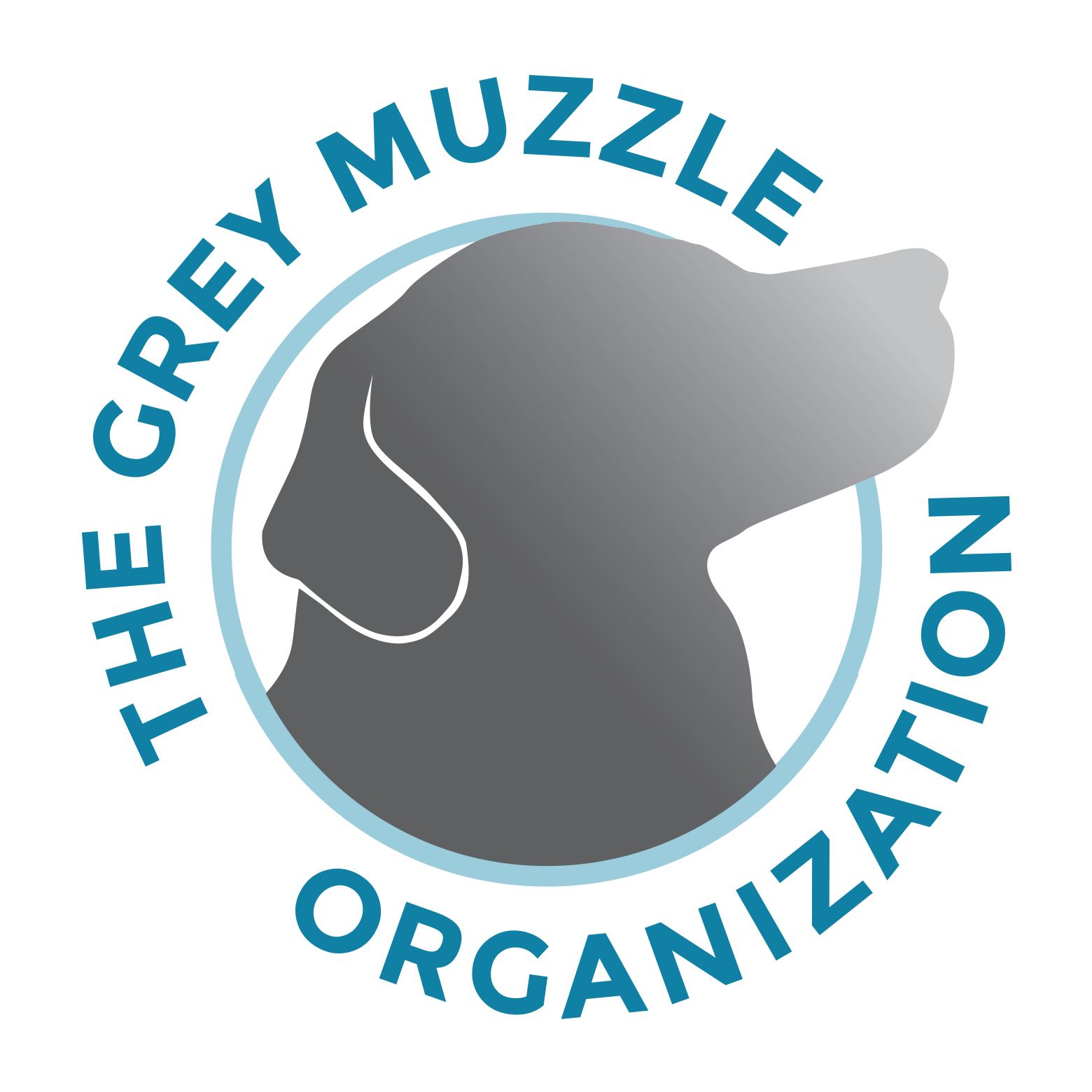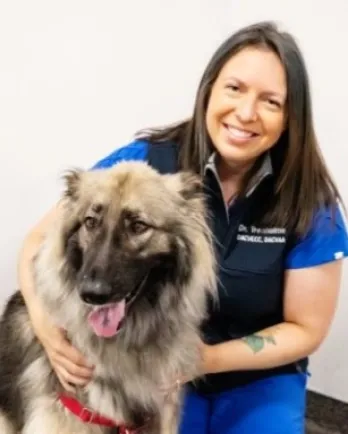Anesthesia and Senior Dogs
As our furry family members age, they often develop health conditions that require ongoing management. Chronic health conditions like kidney and heart disease, among others, are more common in older animals and can complicate the use of anesthesia. That’s why working with your dog’s veterinary team is important, ensuring they understand your dog’s condition and any medications or supplements they are taking.
Dr. Nicole Trenholme recently hosted a webinar for Grey Muzzle on anesthesia and ways the veterinary anesthesia team can address concerns specific to older patients. She also shared how pet parents can help the team provide quality care.
General Recommendations for Pre-Anesthetic Work-Up
Regardless of age, there are a few common areas of concern when it comes to the use of anesthesia in dogs. Before your pet goes under anesthesia, there are many things your veterinarian may want to know. For instance, is your dog eating their typical amount? Are they drinking more water than usual? Are there any new or progressive changes in their habits or behavior? These questions can help determine your pet’s fitness to undergo anesthesia.
Your vet will perform a physical examination to look for points of concern. These could include a too-high or too-low respiratory rate, crackles in the lungs or spontaneous coughing, a new or progressive heart murmur, a poor-quality pulse, or an unusual body temperature.
Additionally, the vet may want to run extra diagnostics for older dogs, such as:
- Chest x-ray to visualize the lungs
- Ultrasound of the heart (echocardiogram)
- Blood pressure
- ProBNP (measures heart chamber stretch)
- Troponin screening (indicates heart damage)
- Complete blood count, biochemistry panel (tests liver & kidney function), and urinalysis
Common Health Concerns in Senior Pets
A few common health issues are critical for veterinarians to know before placing a dog under anesthesia. These include heart and kidney diseases, blood pressure problems, diabetes, Cushing’s disease, and thyroid diseases. If your dog suffers from any of these health concerns, there are specific precautions veterinarians may take to maximize your pet’s tolerance of anesthesia.
Heart (Cardiovascular) Diseases
Your dog’s heart needs to contract (to pump blood out to the rest of the body) and relax (to fill up again). Dogs tend to have issues with their heart's contraction rather than relaxation, which can manifest in many ways.
Valvular Disease
Valvular disease is incredibly prevalent in dogs, especially seniors. According to Dr. Trenholme, it accounts for about 50% of cardiac disease in veterinary patients, 30% of which are geriatric. This condition affects the valves that separate the chambers of the heart. If these valves do not seal properly, some blood will flow back into the left heart chamber, stretching the muscle.
Valvular disease is typically detected initially by a heart murmur. If your vet hears this on a routine visit, they may order a chest X-ray to look for congestive heart failure. If no congestion is present, an echocardiogram or heart ultrasound may be ordered to evaluate the stage of the disease. There are multiple stages to this disease, three of which are asymptomatic, so it is always best to have a vet thoroughly examine your dog before anesthesia.
The protocols for dogs suffering from valvular disease who require anesthesia depend on the severity of the disease:
Type I - Non-clinical patients with pre-existing heart disease require no stabilization before anesthesia.
Type II - Patients with clinical heart disease while at rest or while exercising require stabilization via medication and/or hospitalization before anesthesia.
Type III - Patients with ongoing heart failure shouldn’t undergo anesthesia for elective procedures. For medically necessary procedures, they should be stabilized first via medication, hospitalized well before their procedure, and taken to a surgery center that has a dedicated anesthesiologist on staff.
Regardless of your pet's stage of disease, veterinarians will work to maintain a normal to high heart rate and avoid medications that increase the workload on the heart, worsen blood flow, or reduce heart rate.
Dilated Cardiomyopathy (prevalent in large breeds)
Dilated Cardiomyopathy is when the heart becomes enlarged and “floppy” due to its inability to contract properly. Dogs with this condition often suffer from chamber enlargement, with either left or both sides failing, and an elevated heart rhythm.
When a dog with dilated cardiomyopathy needs to undergo a procedure that requires anesthesia, the vet will first focus on using medication to improve the heart’s ability to contract. During the procedure, they will typically use fewer IV fluids to prevent heart failure, will monitor heart rhythm, and will avoid certain sedatives and pain medications that can negatively affect the heart.
High Blood Pressure (Hypertension)
Systemic Hypertension occurs when a dog’s blood pressure outside their lungs is consistently too high. This can be closely related to both kidney and heart disease. Hormone imbalances, diabetes, elevated thyroid levels, and more can cause it.
If your dog has high blood pressure and must be under anesthesia, your vet will determine their baseline blood pressure. Throughout the procedure, the goal is to stay within 20% of your dog’s unique baseline. A combination of methods, including avoiding certain sedatives, is used to help keep your pet’s blood pressure in a safe range.
High Blood Pressure in the Lungs (Pulmonary Arterial Hypertension)
The blood pressure in the lungs is much lower than in the rest of your dog's body. High blood pressure in the lungs presents different challenges for veterinary surgeons. Pulmonary Arterial Hypertension is most common in toy breeds and dogs with heart or lung disease. It can cause respiratory distress, cough, and lethargy. When a dog undergoes anesthesia, veterinarians use oral medications to normalize the pressure inside the lungs and provide 100% oxygen therapy before surgery.
Chronic Kidney (Renal) Disease
Your dog’s kidneys are a complicated and vital organ. They are responsible for ridding the body of metabolic waste, producing red blood cells, producing hormones, regulating blood volume, balancing electrolytes and pH, and much more. The kidneys receive 22% of total blood flow from the heart, seven times the brain's.
Unfortunately, kidney issues are notoriously difficult to diagnose early, as symptom markers typically don’t show up in labs until the disease has progressed significantly. According to Dr. Trenholme, dogs will only show signs of difficulty concentrating urine after the kidneys have lost 60% of their function. They won’t show elevated kidney values until 75% of function is lost.
Any patient suffering from chronic kidney disease will have their hydration closely monitored, a baseline blood pressure established, a complete blood count, a chemistry panel that checks electrolytes, a pH test, and a good look at the heart. Veterinarians will also want to know about other diseases (comorbidities) that may affect their treatment.
The plan for administering anesthesia to dogs suffering from kidney disease includes minimizing overall stress, minimizing physical pressure on the kidneys, keeping them under anesthesia for as short a time as possible, and monitoring their blood pressure.
Diabetes Mellitus (Decreased Insulin)
In dogs with diabetes, their body is inefficient at producing insulin. Because of this, their sugar or glucose levels can be erratic. The key is to have their diabetes well-regulated before undergoing anesthesia.
Typically, veterinarians have patients fast after midnight before their procedure. Water should always be available. They will want to schedule your pet’s procedure as the first of the day, check their blood sugar levels upon arrival, and treat them depending on current numbers. The goal is to maintain their blood sugar at normal levels throughout the procedure, checking every 30-60 minutes. They will also avoid certain sedatives that increase blood sugar.
Cushing’s Disease (Hyperadrenocorticism)
Cushing’s Disease occurs when your dog’s adrenal glands produce too much cortisol, one of the body’s natural steroids. Typically, a dog develops Cushing’s through a tumor in the adrenal or pituitary glands, which are responsible for making several hormones. Dogs with Cushing’s often also have kidney disease or diabetes.
When dogs undergo anesthesia, veterinarians will closely monitor their blood pressure, watch for excessive bleeding, monitor sodium levels, choose reversible or short-acting drugs, and avoid NSAIDs. They will likely put the dog on a ventilator to reduce the workload on breathing muscles.
Hypothyroidism
While dogs can suffer from both hyper and hypothyroidism, the latter is far more common. This condition occurs when the thyroid functions more slowly, lowering metabolism. It can result in weight gain, hair loss, and painful sores on the skin. At its most extreme, when the thyroid has ceased producing hormones altogether, a dog may show slowed breathing, low blood pressure, hypothermia, and decreased consciousness. In this case, anesthesia will not be used until the dog can be stabilized.
Typically, the veterinarian will advise you to continue hormone replacement medicine at normal dosing leading up to surgery. They will closely monitor cholesterol levels and body temperature before and during the procedure.
General Pre-Anesthesia Prep
For all dogs, there are a few steps that you can take to ensure they are prepared as best as possible for an upcoming procedure:
- Perform a health evaluation as directed by your vet. This may include more advanced testing tools like X-rays, ultrasounds, and blood panels.
- Stabilize chronic conditions as best as you can before elective procedures.
- When it comes to dental procedures, an ounce of prevention is worth a pound of cure. Shorter and less complicated cleanings more often are better than waiting until dental disease has progressed.
- Fast after midnight before anesthesia, but always have water available to your dog.
- Give regular medications the morning of the procedure unless directed otherwise by your veterinarian.
About the Presenter
Dr. Nicole Trenholme, DVM, MS, DACVECC, DACVAA is the medical director at Evolution Veterinary Specialists (EVS). She is double-boarded in Small Animal Emergency and Critical Care (SAECC) and Veterinary Anesthesia and Pain Management. She is a Ross University School of Veterinary Medicine graduate, completing her clinical year at North Carolina State University (NCSU). She completed two internships, one at Friendship Hospital for Animals in Washington, DC, before returning to NCSU for a specialty internship in SAECC. She completed her SAECC residency and master’s degree in biomedical sciences at the University of Missouri, followed by an anesthesia residency at the University of Georgia. She worked as an Assistant Professor at the University of Illinois for two years before joining the EVS team, starting their critical care and anesthesia services and heading up emergency and specialty services.



